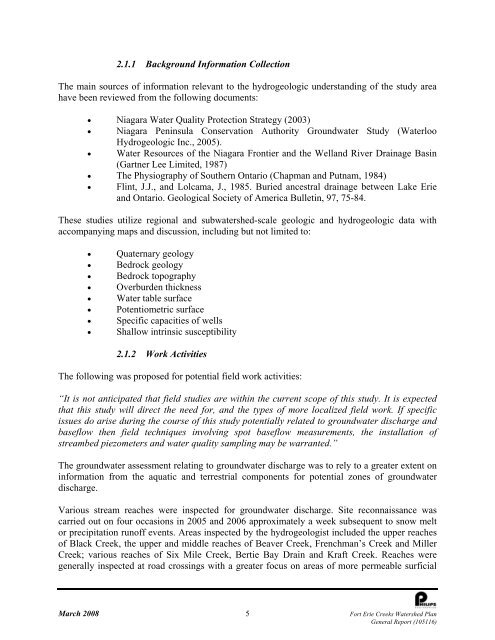Fort Erie Creeks Watershed Plan - Niagara Peninsula Conservation ...
Fort Erie Creeks Watershed Plan - Niagara Peninsula Conservation ...
Fort Erie Creeks Watershed Plan - Niagara Peninsula Conservation ...
You also want an ePaper? Increase the reach of your titles
YUMPU automatically turns print PDFs into web optimized ePapers that Google loves.
2.1.1 Background Information Collection<br />
The main sources of information relevant to the hydrogeologic understanding of the study area<br />
have been reviewed from the following documents:<br />
• <strong>Niagara</strong> Water Quality Protection Strategy (2003)<br />
• <strong>Niagara</strong> <strong>Peninsula</strong> <strong>Conservation</strong> Authority Groundwater Study (Waterloo<br />
Hydrogeologic Inc., 2005).<br />
• Water Resources of the <strong>Niagara</strong> Frontier and the Welland River Drainage Basin<br />
(Gartner Lee Limited, 1987)<br />
• The Physiography of Southern Ontario (Chapman and Putnam, 1984)<br />
• Flint, J.J., and Lolcama, J., 1985. Buried ancestral drainage between Lake <strong>Erie</strong><br />
and Ontario. Geological Society of America Bulletin, 97, 75-84.<br />
These studies utilize regional and subwatershed-scale geologic and hydrogeologic data with<br />
accompanying maps and discussion, including but not limited to:<br />
• Quaternary geology<br />
• Bedrock geology<br />
• Bedrock topography<br />
• Overburden thickness<br />
• Water table surface<br />
• Potentiometric surface<br />
• Specific capacities of wells<br />
• Shallow intrinsic susceptibility<br />
2.1.2 Work Activities<br />
The following was proposed for potential field work activities:<br />
“It is not anticipated that field studies are within the current scope of this study. It is expected<br />
that this study will direct the need for, and the types of more localized field work. If specific<br />
issues do arise during the course of this study potentially related to groundwater discharge and<br />
baseflow then field techniques involving spot baseflow measurements, the installation of<br />
streambed piezometers and water quality sampling may be warranted.”<br />
The groundwater assessment relating to groundwater discharge was to rely to a greater extent on<br />
information from the aquatic and terrestrial components for potential zones of groundwater<br />
discharge.<br />
Various stream reaches were inspected for groundwater discharge. Site reconnaissance was<br />
carried out on four occasions in 2005 and 2006 approximately a week subsequent to snow melt<br />
or precipitation runoff events. Areas inspected by the hydrogeologist included the upper reaches<br />
of Black Creek, the upper and middle reaches of Beaver Creek, Frenchman’s Creek and Miller<br />
Creek; various reaches of Six Mile Creek, Bertie Bay Drain and Kraft Creek. Reaches were<br />
generally inspected at road crossings with a greater focus on areas of more permeable surficial<br />
March 2008 5 <strong>Fort</strong> <strong>Erie</strong> <strong>Creeks</strong> <strong>Watershed</strong> <strong>Plan</strong><br />
General Report (105116)
















